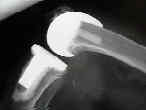
- Discussion:
- tibial component fixation requires a stem to prevent sinking of the implant due to compressive failure of prox
tibial cancellous bone, & shear stresses are high enough in knee to require fixation of tibial tray with
peripheral pegs;
- tibial stem reduces shear forces at the prosthesis bone interface, as well as distributing angulatory load
through upper tibia;
- stemmed component is utilized for pts with severe osteoporosis or in cases where large bone defects are encountered or bone grafts have been used;
- stem length > than 5 cm is probably minimally beneficial in terms of stability;
- in additon longer stem is not necessarily better since some degree of stress shielding of tibial cortex along length will occur;
- tibial plateau may lose its support due to development of fibrous membrane, osteolysis from wear debris, or resorption of grafts;
- in these cases, stem support of the tibial plateau is crucial to prevent fatigue failure of the cantilever plateau;
- Role of Polyethylene:
- tibial prosthesis made of ultra-high molecular weight polyethylene should have a stem to help reduce lift-off, and the stem should be
designed to prevent flexion, extension, varus & valgus angulation, & rotation;
- due to the mechanical properties of ultra-high molecular weight polyethylene, a stem length of more than five centimeters is probably minimally
beneficial in terms of the stability

